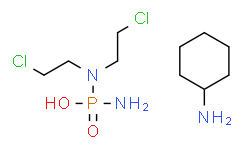| DC73188 |
QBS10072S
|
QBS10072S is a novel dual-function, BBB permeable chemotherapeutic agent with alkylating moiety and a selective large neutral amino acid transporter 1 (LAT1, SLC7A5) substrate, shows excellent BBB penetration and promising efficacy in vitro (U251 cell IC5 |
| DC46283 |
Sibiromycin
|
Sibiromycin is a naturally produced glycosylated pyrrolobenzodiazepines (PBDs). Sibiromycin is also a potent antitumor antibiotic that binds covalently to DNA in the minor groove at the NH2 of guanine. |
| DC42454 |
Treosulfan
|
Treosulfan (NSC 39069, Treosulphan) is an alkylating agent used for conventional and high-dose chemotherapy regimens. Treosulfan is potently cytotoxic against pancreatic cancer cell lines. |
| DC41033 |
Phosphoramide mustard (cyclohexanamine)
|
Phosphoramide mustard cyclohexanamine is the major metabolite for Cyclophosphamide, with anticancer activitiy. Phosphoramide mustard cyclohexanamine induces DNA adduct formation in ovarian granulosa cells, induces DNA damage and elicits the ovarian DNA repair response.
|
| DC41032 |
Phosphoramide mustard
|
Phosphoramide mustard is the major metabolite for Cyclophosphamide, with anticancer activitiy. Phosphoramide mustard induces DNA adduct formation in ovarian granulosa cells, induces DNA damage and elicits the ovarian DNA repair response.
|
| DC40884 |
Phenylacetic acid mustard
|
Phenylacetic acid mustard is the major metabolite of the cancer chemotherapeutic agent Chlorambucil. Chlorambucil is an alkylating agent with antitumor activity.
|
| DC40328 |
PIP-199
|
PIP-199 is a selective inhibitor of RMI (RecQ-mediated genome instability protein) core complex/MM2 interaction, with an IC50 of 36 μM. MM2 is the binding site of RMI complex on Fanconi anemia complementation group M protein (FANCM). PIP-199 can be used for the research of sensitizing resistant tumors to DNA crosslinking chemotherapeutics. |
| DC40300 |
Illudin M
|
Illudin M is a cytotoxic fungal sesquiterpene that can be isolated from the culture medium of Omphalotus olearius mushrooms. Illudin M can alkylate DNA. Illudin M has anti-tumor activities. |
| DC10611 |
Trabectedin
|
Trabectedin (Ecteinascidin-743 or ET-743) is a novel antitumour agent of marine origin with potent antitumour activity both in vitro and in vivo. |
| DC5885 |
Oxaliplatin
|
Oxaliplatin is a second generation potent platinum-based anti-neoplastic agent that is believed to form inter- and intrastrand DNA adducts which activate signaling pathways culminating in apoptosis. The development of Oxaliplatin was inspired from the eff |






















